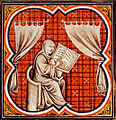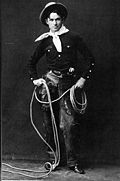Portal:Biography
The Biography Portal
A biography, or simply bio, is a detailed description of a person's life. It involves more than just basic facts like education, work, relationships, and death; it portrays a person's experience of these life events. Unlike a profile or curriculum vitae (résumé), a biography presents a subject's life story, highlighting various aspects of their life, including intimate details of experience, and may include an analysis of the subject's personality.
Biographical works are usually non-fiction, but fiction can also be used to portray a person's life. One in-depth form of biographical coverage is called legacy writing. Works in diverse media, from literature to film, form the genre known as biography.
An authorized biography is written with the permission, cooperation, and at times, participation of a subject or a subject's heirs. An autobiography is written by the person themselves, sometimes with the assistance of a collaborator or ghostwriter. (Full article...)
Featured biographies –
Alexander Frederick Douglas-Home, Baron Home of the Hirsel, KT, PC (/ˈhjuːm/ HEWM; 2 July 1903 – 9 October 1995), known as Lord Dunglass from 1918 to 1951 and the Earl of Home from 1951 to 1963, was a British statesman and Conservative Party politician who served as Prime Minister of the United Kingdom from 1963 to 1964. He was the last prime minister to hold office while being a member of the House of Lords, before renouncing his peerage and taking up a seat in the House of Commons for the remainder of his premiership. His reputation, however, rests more on his two stints as Foreign Secretary than on his brief premiership.
Within six years of first entering the House of Commons in 1931, Douglas-Home (then called by the courtesy title Lord Dunglass) became a parliamentary aide to Neville Chamberlain, witnessing first-hand Chamberlain's efforts as prime minister to preserve peace through appeasement in the two years before the outbreak of the Second World War. In 1940 Douglas-Home was diagnosed with spinal tuberculosis and was immobilised for two years. By the later stages of the war he had recovered enough to resume his political career, but he lost his seat in the general election of 1945. He regained it in 1950, but the following year he left the Commons when, on the death of his father, he inherited the earldom of Home and thereby became a member of the House of Lords. Under the premierships of Winston Churchill, Anthony Eden and Harold Macmillan he was appointed to a series of increasingly senior posts, including Leader of the House of Lords and Foreign Secretary. In the latter post, which he held from 1960 to 1963, he supported United States resolve in the Cuban Missile Crisis and in August 1963 was the United Kingdom's signatory to the Partial Nuclear Test Ban Treaty. (Full article...)
Fifty-nine seconds of the footage were broadcast on television in France with a voiceover from Charles Enderlin, the station's bureau chief in Israel. Based on information from the cameraman, Enderlin told viewers that the al-Durrahs had been the target of fire from the Israeli positions and that the boy had died. After an emotional public funeral, Muhammad was hailed throughout the Muslim world as a martyr. (Full article...)

Josquin Lebloitte dit des Prez (c. 1450–1455 – 27 August 1521) was a composer of High Renaissance music, who is variously described as French or Franco-Flemish. Considered one of the greatest composers of the Renaissance, he was a central figure of the Franco-Flemish School and had a profound influence on the music of 16th-century Europe. Building on the work of his predecessors Guillaume Du Fay and Johannes Ockeghem, he developed a complex style of expressive—and often imitative—movement between independent voices (polyphony) which informs much of his work. He further emphasized the relationship between text and music, and departed from the early Renaissance tendency towards lengthy melismatic lines on a single syllable, preferring to use shorter, repeated motifs between voices. Josquin was a singer, and his compositions are mainly vocal. They include masses, motets and secular chansons.
Josquin's biography has been continually revised by modern scholarship, and remains highly uncertain. Little is known of his early years; he was born in the French-speaking area of Flanders, and he may have been an altar boy and have been educated at the Cambrai Cathedral, or taught by Ockeghem. By 1477 he was in the choir of René of Anjou and then probably served under Louis XI of France. Now a wealthy man, in the 1480s Josquin traveled Italy with the Cardinal Ascanio Sforza, may have worked in Vienna for the Hungarian king Matthias Corvinus, and wrote the motet Ave Maria ... Virgo serena, and the popular chansons Adieu mes amours and Que vous ma dame. He served Pope Innocent VIII and Pope Alexander VI in Rome, Louis XII in France, and Ercole I d'Este in Ferrara. Many of his works were printed and published by Ottaviano Petrucci in the early 16th century, including the Missa Hercules Dux Ferrariae. In his final years in Condé, Josquin produced some of his most admired works, including the masses Missa de Beata Virgine and Missa Pange lingua; the motets Benedicta es, Inviolata, Pater noster–Ave Maria and Praeter rerum seriem; and the chansons Mille regretz, Nimphes, nappés and Plus nulz regretz. (Full article...)
Ion Heliade Rădulescu or Ion Heliade (also known as Eliade or Eliade Rădulescu; Romanian pronunciation: [ˈi.on heliˈade rəduˈlesku]; 6 January 1802 – 27 April 1872) was a Wallachian, later Romanian academic, Romantic and Classicist poet, essayist, memoirist, short story writer, newspaper editor and politician. A prolific translator of foreign literature into Romanian, he was also the author of books on linguistics and history. For much of his life, Heliade Rădulescu was a teacher at Saint Sava College in Bucharest, which he helped reopen. He was a founding member and first president of the Romanian Academy.
Heliade Rădulescu is considered one of the foremost champions of Romanian culture from the first half of the 19th century, having first risen to prominence through his association with Gheorghe Lazăr and his support of Lazăr's drive for discontinuing education in Greek. Over the following decades, he had a major role in shaping the modern Romanian language, but caused controversy when he advocated the massive introduction of Italian neologisms into the Romanian lexis. A Romantic nationalist landowner siding with moderate liberals, Heliade was among the leaders of the 1848 Wallachian revolution, after which he was forced to spend several years in exile. Adopting an original form of conservatism, which emphasized the role of the aristocratic boyars in Romanian history, he was rewarded for supporting the Ottoman Empire and clashed with the radical wing of the 1848 revolutionaries. (Full article...)
During the seven years in which he was active, Joehana wrote a number of stories and articles, as well as several novels. The years of publication are generally unclear, as reprints included neither the year of first publication nor the printing number. Stylistically, Joehana has been classified as a realist owing to his use of the names of actual locations and products in his works, as well as the predominantly vernacular Sundanese in his novels. However, influences from traditional theatrical forms such as wayang and literature such as pantun are evident. Joehana's works cover a wide range of themes, although in general they are oriented towards social criticism and promote modernization. (Full article...)
Sarah Margaret Fuller (May 23, 1810 – July 19, 1850), sometimes referred to as Margaret Fuller Ossoli, was an American journalist, editor, critic, translator, and women's rights advocate associated with the American transcendentalism movement. She was the first American female war correspondent and full-time book reviewer in journalism. Her book Woman in the Nineteenth Century is considered the first major feminist work in the United States.
Born Sarah Margaret Fuller in Cambridge, Massachusetts, she was given a substantial early education by her father, Timothy Fuller, a lawyer who died in 1835 due to cholera. She later had more formal schooling and became a teacher before, in 1839, she began overseeing her Conversations series: classes for women meant to compensate for their lack of access to higher education. She became the first editor of the transcendentalist journal The Dial in 1840, which was the year her writing career started to succeed, before joining the staff of the New-York Tribune under Horace Greeley in 1844. By the time she was in her 30s, Fuller had earned a reputation as the best-read person in New England, male or female, and became the first woman allowed to use the library at Harvard College. Her seminal work, Woman in the Nineteenth Century, was published in 1845. A year later, she was sent to Europe for the Tribune as its first female correspondent. She soon became involved with the revolutions in Italy and allied herself with Giuseppe Mazzini. She had a relationship with Giovanni Ossoli, with whom she had a child. All three members of the family died in a shipwreck off Fire Island, New York, as they were traveling to the United States in 1850. Fuller's body was never recovered. (Full article...)

Herbert James Maryon OBE FSA FIIC (9 March 1874 – 14 July 1965) was an English sculptor, conservator, goldsmith, archaeologist and authority on ancient metalwork. Maryon practiced and taught sculpture until retiring in 1939, then worked as a conservator with the British Museum from 1944 to 1961. He is best known for his work on the Sutton Hoo ship-burial, which led to his appointment as an Officer of the Order of the British Empire.
By the time of his mid-twenties Maryon attended three art schools, apprenticed in silversmithing with C. R. Ashbee, and worked in Henry Wilson's workshop. From 1900 to 1904 he served as the director of the Keswick School of Industrial Art, where he designed numerous Arts and Crafts works. After moving to the University of Reading and then Durham University, he taught sculpture, metalwork, modelling, casting, and anatomy until 1939. He also designed the University of Reading War Memorial, among other commissions. Maryon published two books while teaching, including Metalwork and Enamelling, and many articles. He frequently led archaeological digs, and in 1935 discovered one of the oldest gold ornaments known in Britain while excavating the Kirkhaugh cairns. (Full article...)
Albert Henry Stanley, 1st Baron Ashfield, TD, PC (8 August 1874 – 4 November 1948), born Albert Henry Knattriess, was a British-American businessman who was managing director, then chairman of the Underground Electric Railways Company of London (UERL) from 1910 to 1933 and chairman of the London Passenger Transport Board (LPTB) from 1933 to 1947.
Although born in Britain, his early career was in the United States, where, at a young age, he held senior positions in the developing tramway systems of Detroit and New Jersey. In 1898, he served in the United States Navy during the short Spanish–American War. (Full article...)

Robert Peake the Elder (c. 1551–1619) was an English painter active in the later part of Elizabeth I's reign and for most of the reign of James I. In 1604, he was appointed picture maker to the heir to the throne, Prince Henry; and in 1607, serjeant-painter to King James I – a post he shared with John De Critz.
Peake was the only English-born painter of a group of four artists whose workshops were closely connected. The others were De Critz, Marcus Gheeraerts the Younger, and the miniature painter Isaac Oliver. Between 1590 and about 1625, they specialised in brilliantly coloured, full-length "costume pieces" that are unique to England at this time. It is not always possible to attribute authorship between Peake, De Critz, Gheeraerts and their assistants with certainty. (Full article...)
Theodore Komnenos Doukas (Greek: Θεόδωρος Κομνηνὸς Δούκας, Theodōros Komnēnos Doukas; Latinized as Theodore Comnenus Ducas; died c. 1253) or Theodore Angelos Komnenos was the ruler of Epirus and Thessaly from 1215 to 1230 and of Thessalonica and most of Macedonia and western Thrace from 1224 to 1230. He was also the power behind the rule of his sons John and Demetrios over Thessalonica in 1237–1246.
Theodore was the scion of a distinguished Byzantine aristocratic family related to the imperial Komnenos, Doukas, and Angelos dynasties. Nevertheless, nothing is known about Theodore's life before the conquest of Constantinople and dissolution of the Byzantine Empire by the Fourth Crusade in 1204. Following the fall of Constantinople, he served Theodore I Laskaris, founder of the Empire of Nicaea, for a few years before being called to Epirus, where his half-brother Michael I Komnenos Doukas had founded an independent principality. When Michael died in 1215, Theodore sidelined his brother's underage and illegitimate son Michael II and assumed the governance of the Epirote state. Theodore continued his brother's policy of territorial expansion. Allied with Serbia, he expanded into Macedonia, threatening the Latin Kingdom of Thessalonica. The capture of the Latin Emperor Peter II of Courtenay in 1217 opened the way to the gradual envelopment of Thessalonica, culminating in the city's fall in 1224. (Full article...)

Craig Kieswetter (born 28 November 1987) is an English professional golfer and former cricketer who appeared in 71 matches for the England cricket team between 2010 and 2013. Born and raised in South Africa, Kieswetter moved to England to complete his education, and began playing county cricket for Somerset in 2007. Three years later, he made his international debut in a One Day International (ODI) against Bangladesh. A wicket-keeper batsman, he was considered a one-day specialist, and all his international appearances came in ODIs or Twenty20 Internationals.
Kieswetter played junior cricket for Western Province until the age of 18, but lack of opportunity led him to seek an alternative route in England. He studied at Millfield, where he was noticed by Somerset. The county's lack of a strong wicket-keeper gave Kieswetter his opportunity, and he made his debut for the team early in the 2007 season. Through his Scottish mother, he qualified to play county cricket, and his performances soon generated discussion about his potential to play for England. Around this time, the captain of South Africa, Graeme Smith, invited him to return to play in South Africa but Kieswetter preferred to qualify for England. (Full article...)
Nash quickly became engaged in revolutionary activities, and served as a delegate to the first three Patriot provincial congresses. In 1775, he was named lieutenant colonel of the 1st North Carolina Regiment under Colonel James Moore, and served briefly in the southern theater of the Revolutionary War before being ordered north. Nash was made a brigadier general in 1777 upon Moore's death, and given command of the North Carolina brigade of the Continental Army under General George Washington. He led North Carolina's soldiers in the Philadelphia campaign, but was wounded at the Battle of Germantown on October 4, 1777, and died several days later. Nash was one of ten Patriot generals to die from wounds received in combat between 1775 and 1781. He is honored by several city and county names, including those of Nashville, Tennessee; Nashville, North Carolina; and Nash County, North Carolina. (Full article...)
Born and raised in Kings Mills, Ohio, Alcorn was assigned male at birth and grew up in a family affiliated with the Churches of Christ movement. At age 14, she came out as transgender to her parents, Carla and Doug Alcorn, who refused to accept her female gender identity. When she was 16, they denied her request to undergo transition treatment, instead sending her to Christian-based conversion therapy with the intention of convincing her to reject her gender identity and accept the gender that she was assigned at birth. After she revealed her attraction toward males to her classmates, her parents removed her from school and revoked her access to social media. In her suicide note, Alcorn cited loneliness and alienation as key reasons for her decision to end her life and blamed her parents for causing these feelings. (Full article...)















































